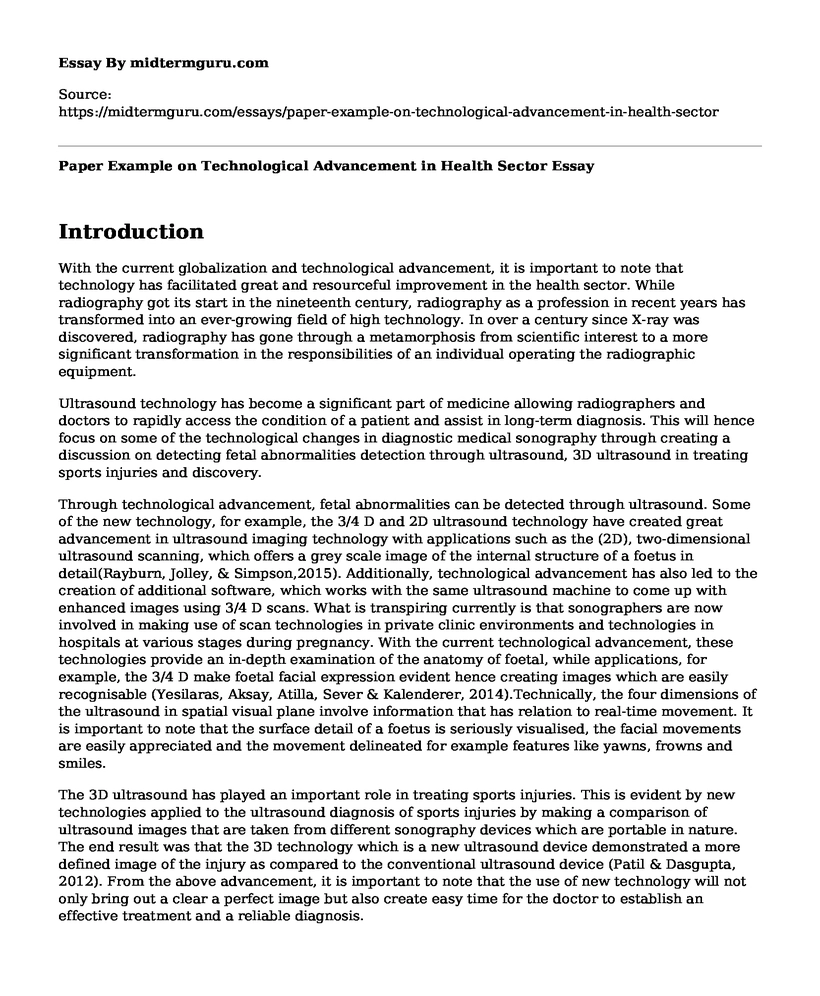Introduction
With the current globalization and technological advancement, it is important to note that technology has facilitated great and resourceful improvement in the health sector. While radiography got its start in the nineteenth century, radiography as a profession in recent years has transformed into an ever-growing field of high technology. In over a century since X-ray was discovered, radiography has gone through a metamorphosis from scientific interest to a more significant transformation in the responsibilities of an individual operating the radiographic equipment.
Ultrasound technology has become a significant part of medicine allowing radiographers and doctors to rapidly access the condition of a patient and assist in long-term diagnosis. This will hence focus on some of the technological changes in diagnostic medical sonography through creating a discussion on detecting fetal abnormalities detection through ultrasound, 3D ultrasound in treating sports injuries and discovery.
Through technological advancement, fetal abnormalities can be detected through ultrasound. Some of the new technology, for example, the 3/4 D and 2D ultrasound technology have created great advancement in ultrasound imaging technology with applications such as the (2D), two-dimensional ultrasound scanning, which offers a grey scale image of the internal structure of a foetus in detail(Rayburn, Jolley, & Simpson,2015). Additionally, technological advancement has also led to the creation of additional software, which works with the same ultrasound machine to come up with enhanced images using 3/4 D scans. What is transpiring currently is that sonographers are now involved in making use of scan technologies in private clinic environments and technologies in hospitals at various stages during pregnancy. With the current technological advancement, these technologies provide an in-depth examination of the anatomy of foetal, while applications, for example, the 3/4 D make foetal facial expression evident hence creating images which are easily recognisable (Yesilaras, Aksay, Atilla, Sever & Kalenderer, 2014).Technically, the four dimensions of the ultrasound in spatial visual plane involve information that has relation to real-time movement. It is important to note that the surface detail of a foetus is seriously visualised, the facial movements are easily appreciated and the movement delineated for example features like yawns, frowns and smiles.
The 3D ultrasound has played an important role in treating sports injuries. This is evident by new technologies applied to the ultrasound diagnosis of sports injuries by making a comparison of ultrasound images that are taken from different sonography devices which are portable in nature. The end result was that the 3D technology which is a new ultrasound device demonstrated a more defined image of the injury as compared to the conventional ultrasound device (Patil & Dasgupta, 2012). From the above advancement, it is important to note that the use of new technology will not only bring out a clear a perfect image but also create easy time for the doctor to establish an effective treatment and a reliable diagnosis.
Conclusion
Technically, anything that is helping a patient discover an issue that is happening in their body and even allowing them to attain good treatment by bringing joy as they see their unborn child is the best thing in managing our future. As result ultrasound technology is creating large employment capacity and raising living standards of individuals as they save lives. The computer is becoming a part of radiographic inspection even if the basis of the techniques and methods of radiography that was established over the past ago remain in use. In the future to come, radiographers will be required to capture images through a digital platform and then emailed to doctors.
Reference
Nur Akin, M., Kasap, B., Akbaba, E., Kucuk, M., Ozturk Turhan, N., Nese Yeniceri, E., & Saglam, A. (2016). Ultrasound in Pregnancy: A Cross-sectional Study of Knowledge and Expectations among Pregnant Women in Southwest Turkey. Medical Bulletin of Haseki/Haseki Tip Bulteni, 54(4).
Patil, P., & Dasgupta, B. (2012). Role of diagnostic ultrasound in the assessment of musculoskeletal diseases. Therapeutic advances in musculoskeletal disease, 4(5), 341-355.
Rayburn, W. F., Jolley, J. A., & Simpson, L. L. (2015). Advances in ultrasound imaging for congenital malformations during early gestation. Birth defects research. Part A, Clinical and molecular teratology, 103(4), 260-268.
Yesilaras, M., Aksay, E., Atilla, O. D., Sever, M., & Kalenderer, O. (2014). The accuracy of bedside ultrasonography as a diagnostic tool for the fifth metatarsal fractures. The American journal of emergency medicine, 32(2), 171-174.
Cite this page
Paper Example on Technological Advancement in Health Sector. (2022, Oct 01). Retrieved from https://midtermguru.com/essays/paper-example-on-technological-advancement-in-health-sector
If you are the original author of this essay and no longer wish to have it published on the midtermguru.com website, please click below to request its removal:
- Description of Risk Factors of Adult and Children Obesity
- Evidence-Based HRM - Paper Example
- Strengths and Weaknesses of the Articles: Workplace Health Promotion
- Reflective Essay on Weymouth Youth and Family Services
- The Health Problem for the Population - Paper Example
- ANA: Unifying Nurses' Voices in the 20th Century - Research Paper
- Nurse's Role in Achieving Patient Compliance in California - Essay Sample







